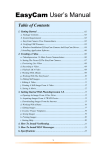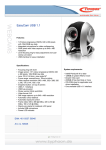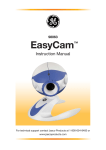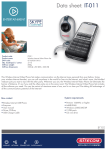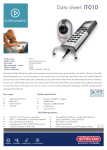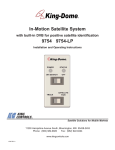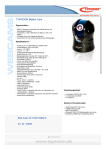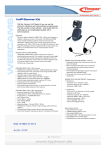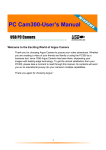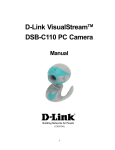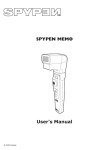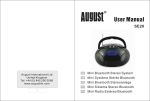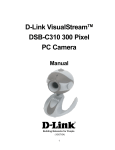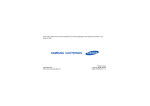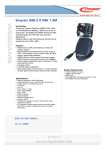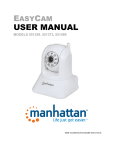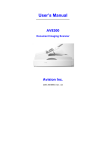Download EasyCam Pro User`s Manual
Transcript
EasyCam Pro User’s Manual Table of Contents 1. Getting Started............................................................................. 02 a. Package Contents ....................................................................................... 02 b. System Requirements.................................................................................. 02 c. EasyCam Pro Camera View Nomenclature ............................................... 02 d. Verifying USB Presence ............................................................................. 03 e. Windows Installation Of EasyCam Pro Camera And Driver..................... 04 f. Installing Application Software................................................................... 06 2. Creating A Video And Single Frame Snapshot ...........................06 a. VideoImpression 1.6 Main Screen Nomenclature....................................... 06 b. Setting The Focus Of The EasyCam Pro Camera....................................... 07 c. Capturing A Single Frame By Using Snapshot Button ............................... 07 d. Previewing Live Video Or Single Frame .................................................... 08 e. Recording A Video Or Single Frame .......................................................... 08 f. Playback Of A Video Or Single Frame........................................................ 08 g. Working With Albums ................................................................................. 09 h. Working With The Storyboard .................................................................... 10 i. Editing Single Frame Snapshots.................................................................. 11 j. Editing A Video ............................................................................................ 11 k. Editing Audio............................................................................................... 11 l. Printing A Snapshot Image Or A Still Image From A Video ....................... 12 m. Saving A Movie .......................................................................................... 12 3. Getting Started With PhotoImpression 3.0 ..................................13 a. Opening An Image From A Disc Drive....................................................... 15 b. Acquiring Images From A TWAIN Device.................................................. 15 c. Downloading Images From The Internet .................................................... 15 d. Working With Albums ................................................................................. 16 e. Editing Images............................................................................................. 17 f. Creative Project Templates.......................................................................... 19 g. Saving Images ............................................................................................. 19 h. Printing Images........................................................................................... 20 i. Getting Help................................................................................................. 20 4. How To Install NetMeeting...........................................................21 5. How To Install MSN Messenger ..................................................22 6. Specifications.................................................................................23 1 Package Contents ● ● ● ● EasyCam Pro Camera USB connector cable Quick Start Guide Installation CD-ROM ○ Camera Driver ○ Application Software ● ArcSoft VideoImpression 1.6 ● ArcSoft PhotoImpression 3.0 ○ User’s Manual System Requirements ● ● ● ● ● Intel Pentium II 350MHz Processor or equivalent 64MB System RAM Windows 98SE/Me/2000/XP CD-ROM drive 16-bit true color display or higher Optional for VideoConference ● ● ● Full- or half- duplex sound card Modem for dial-up connection (or corporate internet) An authorized Internet account (user ID or IP address). EasyCam Pro Camera View Nomenclature 1. Unpacking the EasyCam Pro package and checking components Open your EasyCam Pro package and check the components based on the packing list. Snapshot Button Focus Ring USB Connector Cable 2 Verifying USB Presence Power up your computer and check to see if USB is implemented. Visually inspect the USB ports of your computer. If you cannot find the USB ports at the back of your computer (See Figure 1), read the documentation that came with your computer main board. Figure 1 For computer main board with USB supported: Enter BIOS settings and enable USB, see the documentation that came with your computer. Normally, when the computer power is turned on, before starting windows, the computer will hint you to press some keys for displaying BIOS menu. For computer main board without USB: In this case, USB can be implemented by an USB add-on card. The BIOS settings for main board type USB are not required. 3 Windows Installation of EasyCam Pro Camera and Driver 1. Installing the camera and driver Before installing Camera to your computer, make sure Windows starts up. Then follow the steps below: 1. Plug the camera's connector to the USB port on your computer. (See Figure 2) 2. Check to make sure you have the correct orientation while plugging the USB connector into the USB port of your computer. 3. Once Windows has detected new hardware added to the system, an USB Device message appears on the screen, asking you to search a new device. Figure 2 4. Click “ Next ” to continue. 5. In this dialog box, you will be asked to select a method to search for driver for the camera. Choose “Search for a suitable driver for my device (Recommended).” 6. Insert the EasyCam Pro Installation CD into your CD-ROM drive. Note: Close auto-run window while inserting CD into CD-ROM drive. 7. Click “Next” to continue. 8. The next screen shows the default path for the camera driver, depending on the existing operating system on your PC. For example: Letter D indicates the location of your CD ROM drive. Click “Browser” to select driver location CD-ROM:\Driver on your CD. 4 9. When you have finished the location selection, click “Next” to continue. 10. Windows will search for the EasyCam Pro device and driver location. Note: The driver file should read: d:\driver\twnkcam.inf 11. Click “Next” from the above screen, Windows will copy Driver files into your system. 12. Click “Finish” to complete the EasyCam Pro driver installation. 13. Click “Start”, “Shut Down”, and select option “Restart” to restart your computer. 5 Installing Application Software 1. Insert Installation CD into your CD-ROM drive. 2. An Introduction screen will appear with a menu or CD contents. Note: If the installer screen does not come up automatically, click “Start”, “Run”, and execute the file “cdsetup.exe” on the CD to start the installer program. 3. Click “VideoImpress 1.6”. 4. Follow on screen waited instructions. 5. When installation is complete, the VideoImpression 1.6 Program group will appear as a folder in the Programs menu. VideoImpression 1.6 Main Screen Nomenclature 1. Click Start. 2. Select Programs>ArcSoft VideoImpression> ArcSoft VideoImpression 1.6. 3. The VideoImpression Main Screen will appear as shown below. Control Buttons Timer Window - shows the current frame and the elapsed time within the video. It becomes active when a movie is opened (it will appear as a black box when no movie is open). Video Playback Controls - give you the ability to play, pause, and move forward/backward to specific frames in your movies. New – Starts a new project, opens an existing one, and displays your albums. Edit – Takes you back to the Storyboard (only when you have a project open.) Save – Saves your work as a movie file in AVI format. Send – Allows you to email your movie files. (A MAPI-compliant email program is needed for this option.) Control Buttons (1) (“!”) Tips toggles pop-up tool tips on/off. When on, icon names will popup when you move your mouse over an icon. (2) (“?”) Help launches VideoImpression Help. You can learn more about program functions and procedures by using Help. (3) (“-”) Minimize moves VideoImpression to the background and places it in the Windows taskbar. (4) (“x”) Close closes VideoImpression. 6 Setting the Focus 1. 2. 3. Click Start> Programs> ArcSoft VideoImpression 1.6> ArcSoft VideoImpression 1.6. The introduction screen will appear with a menu of software contents. Click “ New. ” 4. Select “Capture” . The window shows a Live preview as seen from the EasyCam Pro. To focus the picture, turn the focus ring (the grooved plastic ring around the lens of the camera) until the image becomes sharp. 5. Capturing a Single Frame by Camera Snapshot button 1. 2. 3. 4. 5. Click Start> Programs> ArcSoft VideoImpression 1.6> ArcSoft VideoImpression 1.6 The introduction screen will appear with a menu of software contents. Click “ New. ” Select “ Capture ”. The window shows a Live preview as seen from the camera. Press the sanpshot button (located on top of the camera-see EasyCam Pro Camera Nomenclature on Page 2) to capture a single frame. 7 Preview Live Video or Single Frame 1. Follow steps 1~3 in “Set the Focus” to enable live preview. 2. To stop preview, click on “Stop” ( ). 3. To resume preview, click on "Preview" ( ). Record a Video or Single Frame 1. 2. 3. 4. Follow steps 1~3 in “Setting the Focus” to enable live preview. To start video recording, click on “Record” ( ). To stop video recording, click on “Stop” ( ) or ESC. To save captured video, click on “Save” ( ). Playback a Video or a Single Frame 1. 2. 3. 4. 5. In VideoImpression Main Screen, select “New.” Select source for replay by clicking on “Get” or by choosing from the drop down menu. The Selected video appears on album. (See Editing a Video or Single Frame – Page 2) Double click the source to add it to Edit Board. To replay captured video, click on “Play.” 8 Working with Albums You can create movies by placing image and movie files onto the Storyboard from various Albums. To create a movie, do the following: 1. Click on the New icon from the Main Screen. This will take you to the Album Screen. 2. Use the options on the Album Screen to construct your movie. Select Album - (Located immediately to the right of the album name) Lets you choose the album you wish to view or work from. Selecting “New” will bring up a new, empty album. You can name/rename an album by clicking in the box with the album name and typing over the existing text. Get - Opens a window that allows you to browse through your computer to add image, movie, or audio file thumbnails to the current album. You can add thumbnails for supported file formats on your hard drive or any removable media (diskettes, CDs, etc.). Acquire - Enables you to get images from TWAIN devices like digital cameras and scanners. After clicking this icon, select the device you are using, and follow the procedures provided for that device. Capture - Allows you to acquire video from a video source or still images from digital cameras. Sort - Offers you options to arrange your thumbnails for easy management. Add To Storyboard - Places the currently selected thumbnail on the next available frame on the Storyboard. (Note: You can also add an image to the Storyboard by clicking and dragging the thumbnail to it.) Play Movie - Takes you back to the View Screen where you can play, save, and email your movie. Edit Movie - Lets you modify movie or still image files. You can add text as well. 9 Working with the Storyboard Note: The Storyboard shows you each step or part of the movie that you are creating. You can add a thumbnail to your Storyboard by drag-n-drop, or by highlighting a thumbnail and clicking on the Add To Storyboard icon. Text Transition Thumbnail Image Sound Tracks Text - Is highlighted if there is text added to the respective thumbnail. You can add text by clicking on the thumbnail and then the Edit Movie icon. Transition - Is an effect that is applied as scenes in your movie change. You can add a transition by double-clicking on a Transition icon between two thumbnails, or by clicking on the Transition icon when editing a still image or video file. This will take you to the Transition Screen, where you can choose from several transitions in different categories. You can simply drag the transition you want to the desired location, before or after a thumbnail on the Storyboard. Thumbnail Image - Displays a still image file, or the first frame of a movie file, for a specific area on the Storyboard. You can edit a movie or still image file by clicking on its thumbnail, and then on the Edit Movie icon. Soundtracks - Show audio files that will play during the movie. You can add up to two different audio files for simultaneous playback. You can add audio files to the Storyboard the same way that you add still image and movie files. You can rearrange the audio files by dragging them to the desired location on the sound tracks. 10 Editing Single Frame Snapshots To edit still images, double click on the review window in “Still Image Template” Play Movie - Takes you back to the View Screen where you can play, save, and email your movie. Transitions - Takes you to the Transitions Screen (See “ Options on the Storyboard ” ). Album - Takes you to the Album Screen (See “Working with Albums” ) Text - Allows you to add text to images. You can select the font type, style and size. You can also apply effects to the text, and adjust their duration. Brightness Slider - Allows you to change the brightness of an image. This is the top slider below the preview window. Contrast Slider - Lets you adjust the contrast of an image. This is the bottom slider below the preview window. Editing a Video To edit a video, double click on the preview window in “Video Template” Play - Starts the video. Pause - Stops the video. Clicking the button again resumes play. Previous Frame (-) - Moves the video back one frame. Next Frame (+) - Moves the video forward one frame. Playback Slider - Shows a marker that moves across the slider as the video plays. Starting Mark - Allows you to set where you want the video to begin (the green mark). Ending Mark - Lets you set where you want the video to finish (the red mark). Note: If you are a PC user, you can adjust the starting/ending frame by right-clicking the video and selecting “Setting” in the pop-up window . Editing Audio To edit Audio, Play - Starts the audio. Pause - Interrupts the audio (Clicking the button again will resume the audio) Forward - Moves the audio forward Reverse - Moves the audio backwards Audio Volume – Adjusts the volume of the audio Starting Mark - Sets the beginning point of the audio Ending Mark - Sets the ending point of the audio 11 Printing a Snapshot Image or a Still Image from a Video 1. From the Edit Screen, select the video frame you want to print. 2. Right-click the video and select “Print.” Saving a Movie 1. 2. 3. 4. Click on Save on the Main Screen. In the Save As window, select the drive and folder that you want to save the movie to. Give the file a name, and select what type of movie you want to save it as. Click Okay to save, or Cancel to abort 12 Getting Started with PhotoImpression 3.0 1. Click Start. 2. Select Programs>ArcSoft PhotoImpression>PhotoImpression 3.0. The PhotoImpression Main Screen will appear on your desktop. Navigation Window Magnification Controls Command Buttons Toolbar Main Screen Options on the Main Screen: - Opens images from an album (Album), a disk drive (From Folder), or from photo-sharing website (Online Service). You can also acquire images from TWAIN devices (Camera/Scanner), get screenshots (Screen Capture), and create new images from scratch (Create New). -Brings up editing tools for manipulating images. Options include Crop/Resize Retouch, Text, Enhance, Effects, and Layers. - Brings up creative options, including Frames & Edges, Cookie Cutter, Calendars, Greeting Cards, and PhotoFantasy. It also allows you to access other programs (Cool Software). - Lets you save the current image (To File: Save), save the image as a different file (To File: Save As), attach the image to an email at various sizes (Email—a compliant email program is required), set the image as your wallpaper (To Desktop: Wallpaper), and upload the image to a photo-sharing website (To Internet: Upload). - Offers three printing options: one image per page (Standard Printing), multiple images per page and greeting card templates (Greeting Card/Multiple Printing), and album printing (Thumbnail Printing). View Controls: Navigation Window - Shows a miniature view of the current image. Even if you zoom in on a specific part of the image, you will still be able to see the whole picture in the Navigation Window. You can drag the box in the Navigation Window to focus on specific areas of the image. Magnification Controls - Display the currently viewed size of the image as a percentage. They allow you to zoom in (+), out (-), or reset the image to its original, full size (1:1). The Full Screen icon (to the right of the 1:1 icon) allows you to display the image on the entire screen. You can get out of the full screen mode by pressing the Esc key on the keyboard. 13 Toolbar: - Resizes the image when the corner handles are dragged. You can also reposition the image by dragging it. - Rotates the image at the user’s discretion. - Applies a mirror effect to your image by flipping it. - Rotates the image in 90-degree increments. - Cancels the last unsaved change you’ve made. - Reverses the last action you’ve undone. - Copies the selected area, layer, or image onto the Clipboard. - Pastes what’s on the Clipboard onto the selected image as a new layer. - Deletes the currently selected layer. - Closes the currently selected image. 14 Opening An Image From A Disk Drive You can open an image that is stored on your hard drive, floppy disk, CD-ROM, etc. 1. Click the Get Photo button on the Main Screen, and select From Folder. 2. Click Browse. A Browse for Folder dialog will appear. 3. Navigate to the folder that you wish to view. Highlight the folder and click OK. 4. Thumbnails of the images within the selected folder will appear. Highlight the desired thumbnail, and click OK (or double-click it). Acquiring Images From A TWAIN Device 1. Click the Get Photo button on the Main Screen, and select . 2. From the pull-down, select the desired device. 3. From the pull-down, select the desired album to which the acquired file will be added. 4. Click the Acquire Options button to set the Twain options. Options include setting the file type for acquired images, setting the save directory, and specifying the file name prefix. 5. Click the Acquire or Video Camera button (depending on your source), and follow the directions specific to your device to acquire or capture an image. Downloading Images From the Internet 1. Click the Get Photo button. 2. Click the Online Service button, and then click the Download button. 3. Follow the instructions onscreen to download images from the supported photosharing website. 4. Follow the instructions onscreen to download images. Note: You must have an account with the photo-sharing site you are connecting to. 15 Working with Albums Photo albums allow easy identification and access to images for viewing, editing, printing, etc. Simply click on the Get Photo button on the Main Screen, and select Album to view the album options. It is important to remember that albums do not store images. When an album is created, thumbnails are generated and a reference to where the files are located is recorded in the album file. For example, if a thumbnail is added into an album from a floppy disk, that floppy disk must be in the floppy drive in order to view the file. Album Tools: Album Selector - Allows you to view your albums through a pull-down. You can select “[New]” to start a new, blank album. You can give the new album a name by typing over "New Album 1"(PC), or “Untitled” (Mac). - Launches an Open dialog that allows you to browse your system to select files you’d like to add to the current album. You can add multiple files at one time by holding down Ctrl (PC) or Shift (Mac) while clicking on each file to be added. You can also add a range of files by holding down the Shift key while clicking on the first and last file (Windows only). - Launches a Find dialog allows you to find image files in an album or on your system. - Launches the Slide Show dialog with options that allow you to run a slide show of the images in the current album. - Allows you to sort the thumbnails in your album by name, type, size, or date. - Removes the selected thumbnail(s) from your album. You have the option of removing only the thumbnail or both the thumbnail and the image file. Removing the image file will delete it permanently from your system. View Album – Creates a “virtual notebook” and flips through the images in an album. Album Screen Saver (Windows only) – Allows you to create a slide show screen saver for your system. 16 Editing Images Click the Edit button on the Main Screen to display the various editing options. Crop/Resize: - Allows you to select a rectangular area on an image. - Works the same as the Rectangle tool except a circle is drawn instead of a rectangle. - Allows you to make a "freehand" selection by clicking and dragging over the image in a desired path or shape. You can select a polygonal area by clicking on the points of the desired shape in a connect-the-dots fashion. - Selects an area of an image based on color similarity. - Inverts the selection on an image. For example, if you’ve created a rectangular selection and then used the Inverse tool, the area selected would be outside of the box instead of inside. Copy Selection As New Layer - Creates a new layer out of the selected area. Soft Edge Slider - Gives cropped edges a warm fade based on the position of the slider. Apply To All Layers - Crops all layers to the selected area when checked. Crop - Crops the image to only show areas that have been selected. Width – Allows you to enter in a new width (in pixels) for the image. If the Keep Aspect Ratio box is checked, the Height will automatically change accordingly. Height – Allows you to enter in a new height (in pixels) for the image. If the Keep Aspect Ratio box is checked, the Width will automatically change accordingly. Wscale – Allows you to enter in a new image size by width percentage. For example, entering “50” would make the image _ its current width. If the Keep Aspect Ratio box is checked, the Hscale will automatically change accordingly. Hscale – Allows you to enter in a new image size by height percentage. For example, entering “200” would make the image twice its current height. If the Keep Aspect Ratio box is checked, the Wscale will automatically change accordingly. Resize – Finalizes any resizing that you’ve done. Retouch: - Offers various sizes for certain editing tools. The larger the brush size, the larger the affected area when a tool is used. The Intensity slider adjusts the degree of effect applied. - Offers various colors for use when painting or doing other color editing. The two color squares on the left of the Color Palette show you the active (top) and alternative (bottom) colors. You can change the alternative color to the active color simply by clicking on it. - Turns the mouse pointer into a paintbrush tip and applies an opaque layer of the active color to the current layer. - Works similar to the Paintbrush tool but draws like a felt-tip pen or marker. - Simulates the effect of a spray can, putting a light layer of color on the active layer. - Removes color on a layer, making it a transparent background (white). - Duplicates a selected area of an image to another location. Right-click (PC), or Shift-click (Mac) to select the clone source, which will be indicated by a plus (+) sign. Then click and drag over the area of the image to be painted with the clone source. - Simulates the effect of a finger smearing wet paint. 17 - Reduces the red-eye effect common in flash photography. - Smoothes rough edges. - Sharpens fuzzy areas. - Lowers brightness. - Raises brightness. - Lets you set a color on your image as the active color. - Covers the area you click on (based on color similarity) with the active color. - Fills a layer or image with a selected pattern. - Fills the current image or layer with a gradient from the alternative color to the active color. Select the desired colors in the Color Palette, click at the point where you want the gradient to start, and drag to designate the length and direction of the transition. Text: When text is added, a new layer will be automatically created. Settings include font, style, size, and color. You can add a shadow to the text as well. Enhance: - Applies a quick, overall enhancement to an image with one click. - Allows you to adjust the brightness and contrast of the current layer. - Allows all the colors on the same layer to be shifted by the same degree (hue), and adjusts the intensity of the colors (saturation). - Can be used to adjust the highlight, midtones, and shadow of the selected layer. It offers more control than Brightness/Contrast. -Decreases the contrast between adjacent pixels, creating a fuzzy effect over the entire layer. - Pixelates the entire layer, eliminating smoother edges in the image. - Evenly redistributes the grayscale or color values of the pixels in an image. The effects are varied depending on the image, but in general, the lines in the highlight and shadow areas will be sharpened. - Inverts the grayscale or color brightness values for the entire layer. This will make your image look like a photographic negative. Effects: PhotoImpression includes a variety of special effects to transform images in a number of interesting ways. Click on a desired effect to preview it on your image. You can use the Intensity slider to adjust the intensity of the effect. To keep the effect, click Apply. To cancel, choose any other effect or click a different button. Layers: The Layers Palette shows thumbnails of each layer. The currently selected layer will have a highlight around the thumbnail. Toggling the green light above the thumbnail on and off displays and hides the layer, respectively. The slider above the thumbnail adjusts the transparency of the layer. Note: An image can have multiple layers. You can retain separation of the multiple layers of an image only if it is saved as a PSF file. 18 Creative Project Templates Click on the Create button on the Main Screen to see the create options. : You can add a frame or edge to an image by selecting the option you wish, and then clicking Apply. (You can preview different options before settling on a particular one.) : You can "stamp" out a template of your image by selecting the shape you want to use, and then clicking Apply. : You can create customized calendars by inserting your image into a calendar template. Select the month, year, and style that you want, then click Apply. : Several different styles of greeting cards are available for you to use with your images. Simply choose a style that you like, then click Apply. : You can create hilarious “fantasy” pictures from many templates in various categories. Simply select the template that you want, use the Toolbar to fine-tune your image within the fantasy template, and click Apply when done. Note: ArcSoft PhotoFantasy allows you to access more fantasy templates and easily create your own. Visit www.arcsoft.com for details. : You can easily open your favorite image-editing programs from the Cool Software section. To add a program, click the Add button and browse through your computer to find the application file you wish to add. A program icon will appear on the Cool Software Palette. Saving Images Once you’ve clicked on the Save button on the Main Screen, the following options will become available: To File: - Saves the changes that you’ve made to the existing file. - Allows you to save the file in a new location, with a new name, and even a new file type. Email (Windows only): If your email program is MAPI-compliant, you can use PhotoImpression to open a new mail message and automatically attach the current image to it. Note: If your email program is not MAPI-compliant, or if MAPI is not enabled in the program, You will not be able to use this function. You can use the “insert” or “attach” function in your email program to manually select the image file(s) for inclusion in an email. To Desktop (Windows only): Click the Wallpaper button to set the current image as your desktop wallpaper. To Internet: Click the Upload button to upload images to a supported photo-sharing website. 19 Printing Images PhotoImpression provides four different printing options: • Standard Printing: prints one image per page. You can add a title, center the image and title, change the paper orientation, add a frame (a black outline) around the image, resize the image, and select the number of copies (Windows only) that you want printed. Additional options include Auto Rotate (the program rotates the image to best fit the page), Auto Crop (the program crops the image to maximize the print area), and Nudge (allows you to make slight adjustments to compensate for printer alignment). • Greeting Card/Multiple Printing: prints more than one image per page. There are several templates for you to choose from, including greeting card templates. Your albums will be displayed. You can easily drag and drop images from your album to specific areas on a selected template. You can change the space between the images on a template as well. Additional options include Auto Rotate, Auto Crop, and Nudge. You can also add text to a specific image on a template by clicking the Set Text button. The Erase All button clears the template of all images. • Thumbnail Printing: prints album thumbnails. You can print an entire album, or specific thumbnails. You can also choose different spacing options, add file names below the images, and review every page to be printed. Getting Help PhotoImpression provides extensive online help. If you need more information or instructions on how to use a specific feature or tool, click the Help (?) button in the upper right-hand corner of the screen. 20 How to Install Microsoft NetMeeting 1 How To Install NetMeeting (XP includes as standard) 1.1 For Windows 98/Me Users Click Start, point to Programs, point to Accessories, point to Internet Tools and then click NetMeeting. For Windows 2000 Users Click Start, point to Programs, point to Accessories, point to Communications, and click NetMeeting. 1.2 Click Next, type the appropriate information in the First Name, Last Name, E-Mail Address, Location, and Comments dialog boxes, and then click Next. NOTE: The Location and Comments information is optional. 1.3 Click Next, click to select the Log into a directory server when NetMeeting starts check box (this is optional), and then type the name of the directory server in the Server Name dialog box. If you do not want your name to be visible in the directory, click to select the Do not list my name in this directory check box. 1.4 Click Next, and then select the appropriate location for the shortcuts. 1.5 Click Next, follow the instructions in the Audio Tuning Wizard, and then click Finish. After you run NetMeeting for the first time, you can modify the information you entered about yourself or the directory server name that you want to connect to. To do so, click Options on the Tools menu, click the General tab, and then enter the appropriate information. Also, you can run the Audio Tuning Wizard again, and to do so, click Audio Tuning Wizard on the Tools menu. If you can't install the NetMeeting from your PC directly, please log on to http://www.microsoft.com/windows/netmeeting/ to download. 2 How To Start With The Camera 2.1. Plug the camera into your PC first. 2.2. Click the "NetMeeting" to go to the main screen, and then click "Start Video" button, then you can start working with NetMeeting. 2.3. If you need more information or instruction on how to use a specific feature or tool, click the "Help" button in the upper right-hand comer of the screen. 21 How to Install MSN® Messenger 1. How To Install MSN Messenger 1.1 For Windows 98/Me/2000 Users 1.1.1 Please log on to http://messenger.msn.com to download. After the installation package is downloaded to your computer, it will start installing MSN Messenger. All you have to do is follow the instructions. 1.1.2 After the installation is completed, click Start, point to Programs, and click Windows Messenger. 1.2 For Windows XP Users 1.2.1 Click Start, point to Programs, and click Windows Messenger. 1.2.2 After you run Messenger for the first time, you can add friends to your list and send instant messages. 2. How To Start With The Camera 2.1 Plug the camera into your PC first. 2.1.1 For Windows 98/Me/2000 Users Click the “Messenger” to go to the main screen, click NetMeeting, then you can have a Video Conversation with NetMeeting. For more details about NetMeeting, please refer to “How to Install NetMeeting”. 2.1.2 For Windows XP Users Click the “Messenger” to go to the main screen, click Actions, click Start a Video Conversation, then you can have a Video Conversation with Messenger. If you need more information or instruction on how to use a specific feature or tool, click the “Help” button in the upper right-hand comer of the screen. 22 Specifications Sensor CMOS with 300K Pixels Color Depth 24 Bits, 16.7 million RGB true color Interface USB V1.1 White Balance & Gain Automatic Exposure Automatic Focus Range Manual, 10cm~infinity View Angle 52° (diagonal) Aperture F/2.6 H/W Snapshot Yes Anti-Flicker Yes Video Output Resolution 640X480, 352X288, 320X240, 176X144, 160X120 Video Frame Rate Up to 30 fps Microphone Built-in Video Data Format RGB24, I420 File Format JPEG (still image) AVI (streaming video) Camera Control Settings Contrast, Brightness, Saturation, Sharpness, Exposure Dimension 68mm(L)X85mm(W)X83.5mm(H) w/stand Driver Compliance Video for Windows, WDM, TWAIN OS support Microsoft Windows 98SE/2000/ME/XP 23























